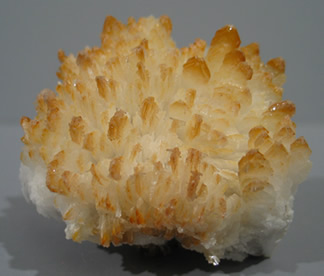![]()
Gallery 1 of Sold Specimens, A-E
Gallery 2 of Sold Specimens, F-Z
![]()
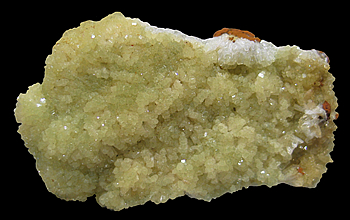
ordinary light
click
on image for larger view
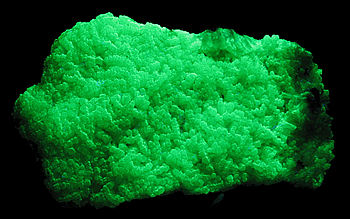
SWUV click
on image for larger view
ADAM8-2 Adamite $48 SOLD
Ojuela Mine, Mapimi, Durango, Mexico
9 x 5 x 2 cm
A rich covering of yellow Adamites (Zn2(AsO4)(OH)) on a plate of Limonite, with bright green fluorescence under SWUV.
![]()
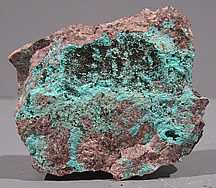
click on image
for larger view
AJO6-1 Ajoite $28 SOLD
Ajo Mine, Ajo, Little Ajo Mts, Ajo District, Pima Co., Arizona (TL)
4.3 cm x 3.8 cm x 2.1 cm
Needles of green-blue Ajoite (K,Na)Cu7[(OH)6|AlSi9O24] · 3H2O from the type locality are visible with the naked eye, but are much prettier with a loupe or microscope. Some dark material is sprinkled over the Ajoite, but even at 60x, there is no visible crystal structure in the overlying dark material to aid in guessing its identity.
![]()
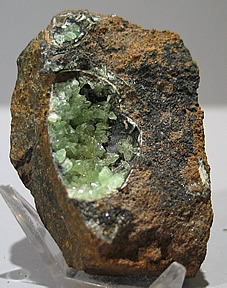
click on image
for larger view
ANAP9-1
Anapaite in Fossil Clam Shell $48 SOLD
Kerch peninsula, Crimea peninsula, Crimea Oblast', Ukraine
3 cm x 5.2 cm x 2.2 cm
Green Anapaite Ca2Fe2+[PO4]2· 4H2O crystals fill the remnants of a pair of fossil clam shells in matrix.
![]()

click on image
for larger view
ANTIM9-1
Antimony $42
SOLD
Velez-Malaga, Costa del Sol, Malaga Province, Andalucia, Spain
4.8 cm x 3 cm x 2.5 cm
A mirror-bright vein of native Antimony (Sb) runs through this specimen, displaying some crystal faces. I'm not sure why mineral people always use "native" in front of any naturally-occuring pure element, except perhaps to emphasize that it occurred in its pure form without help from any refinery?
![]()
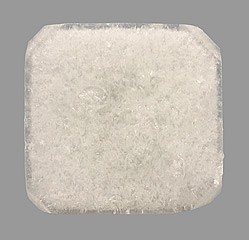
click on image
for larger view
APOP8-1
Apophyllite-(KF) $25 SOLD
Nasik, Poonah, Maharashtra, India
2.9 cm x 2.9 cm x 0.6 cm
A curiously flat, tabular crystal of Fluorapophyllite, now called Apophyllite-(KF) (KCa4[(F,OH)|Si8O20] • 8H2O), from the well-known locality of Nasik. While the body is opaque white, the very outermost edges grade to clear. An interesting and different toenail-sized mineral specimen.
![]()

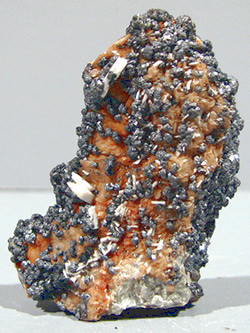
click on image
for larger view
AgG9-1 Argentiferous Galena $42 SOLD
Eagle Mine, Gilman, Gilman District, Eagle Co., Colorado
5.8 cm x 3.8 cm x 2.5 cm
Galena (PbS) and Silver (Ag) mixed together is known as Argentiferous Galena. Under the loupe or microscope, you can see that what appears to be rough, distorted crystals are actually mounds of crystals that show both square and hexagonal faces. Galena is known to form pseudohexagonal twins, so I suppose that could be what is happening here, especially with the Silver wild card thrown in.
![]()
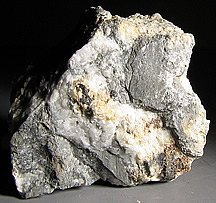
click on image
for larger view
ALAMP9-1 Arsenolamprite in Calcite $25 SOLD
Gabe
Gottes Mine, Ste Marie-aux-Mines (Markirch),
Haut-Rhin, Alsace, France
3 cm x 2.4 cm x 2.2 cm
Arsenolamprite is a fancy name for native Arsenic (As), and it hails from the French city that hosts Europe's second largest mineral show, Ste Marie-aux-Mines. This specimen comes with the previous owner's label.
![]()

click on image
for larger view
Q5-06
Arsenopyrite in Quartz $52 SOLD
Yaogangxian Mine, Yizhang Co., Hunan Province, China
3.3 cm x 4.3 cm x 3.5 cm
A crystal of Arsenopyrite (upper left) plunges deeply into a Quartz crystal. Behind the Quartz is some more Arsenopyrite (FeAsS to (Fe0.9Co0.1)AsS), Muscovite and Chalcopyrite.
![]()

click on image
for larger view
ART9-1
Artinite $19 SOLD
Artinite Pit, Clear Creek Area, San Benito Co., California
4.6 cm x 1.3 cm x 2 cm
Spikey white Artinite Mg2[(OH)2|CO3] · 3H2O crystals like a patch of white grass.
![]()
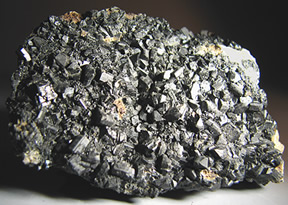
click on image
for larger view
BAB9-1 Babingtonite $45 SOLD
Grönsjöberget, Borlänge, Dalarna, Sweden
5.5 cm x 3.8 cm x 3.5 cm
A rich covering of black Babingtonite Ca2(Fe,Mn)FeSi5O14(OH) crystals to 5mm from an old limestone quarry. Nestled among the Babingtonites are a few small Quartz crystals.
![]()
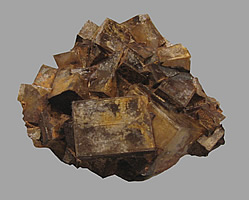
click on image
for larger view
BAR5-02
Barite $35 SOLD
North of Butte, Silver Bow Co., Montana
4.6 cm x 3.7 cm x 1.7 cm
Barite (BaSO4) from Montana is not that commonly available. This specimen of chunky crystals up to 1.6 cm on an edge was formerly in the collection of Roni and Bill Plavac, and comes with their label. The crystals are sharply formed and have a good luster; I had to angle the specimen away from reflections or the photo would have been saturated. The crystals have tan and brown inclusions which make them look a bit like blocks of wood.
BAR5-5 Barite $60 SOLD
Hammam-Zriba Mine, Hammam-Zriba, Djebel Guebli, Tunisia
7.3 cm x 6.7 cm x 5.5 cm; Barite crystals to 4.5 cm
A large, visually striking cluster of sword-shaped white Barites with iron-stained tips from northeastern Tunisia.
![]()

click on image
for larger view
BPW9-8 Barite on Petrified Wood (A. Arizonicum) $25 SOLD
Petrified Wood Ranch, Puerco Ridge, Navajo Co., Arizona
8.3 cm x 4 cm x 2.4 cm
Feathery white Barite (BaSO4) sits in a cluster atop a chunk of petrified wood from Araucaria Arizonicum, a conifer that is the Arizona state fossil. The Barite fluoresces cream color under both LWUV and SWUV. This specimen was collected by Ken Gochenour a couple of years ago.
![]()

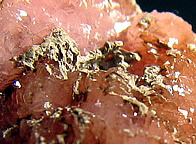
click on image
for larger view
image on right is 7 x 6 mm
BEMEN9-1 Bementite on Rhodochrosite $35 SOLD
N'Chwaning II Mine, Kalahari Manganese Field, South Africa
2.9 cm x 2.1 cm x 2.5 cm
Sparkly balls of pink Rhodochrosite, MnCO3 are accented by fibrous-looking, tan Bementite, Mn5Si4O10(OH)6. Under a microscope, the Bementite looks more crusty and less fibrous, and some of the Rhodochrosite is seen to have a deeper color reminiscent of the Olmiite/Poldervaartite that comes from this mine. Bementite was named for Clarence Sweet Bement [1843-1923] in 1887. Bement was extremely interested in the minerals of Franklin, NJ (the type locality for Bementite), and he assembled the finest mineral collection of his time in the US. Eventually he sold it to J. P. Morgan, who gave it to the American Museum of Natural History. The collection required two railroad cars to bring it to New York!
![]()
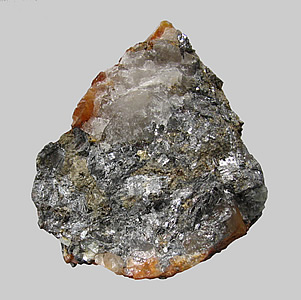
click on image
for larger view
BISM8-1
Bismuthinite $55 SOLD
Brosso Mine, Cálea, Léssolo, Canavese District
Torino Province, Piedmont, Italy
5 cm x 5.5 cm x 3 cm
An aggregate of shiny metallic Bismuthinite (Bi2S3) crystals from a one-time find around 1950 in the Pyrite mines of Brosso. When photographing this for the website, I unintentionally shot two photos from slightly different angles, so for fun, I tried pairing them into a 3-D image and it worked! If you want to see the 3D version, click here: 3D
![]()
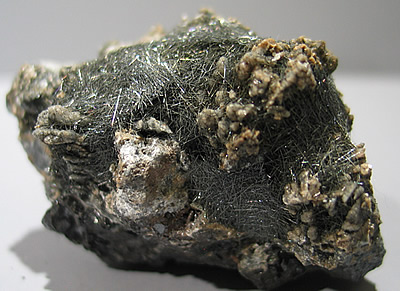
click on image
for larger view
BOUL9-1 Boulangerite $44 SOLD
Concepción del Oro, Mun. de Concepción del Oro, Zacatecas, Mexico
6 cm x 4 cm x 5.5 cm
Wirey Boulangerite Pb5Sb4S11 richly covers one end of this mineral specimen.
![]()
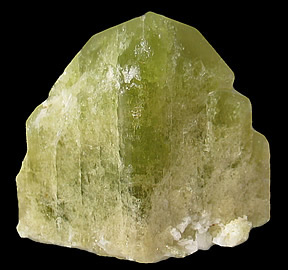
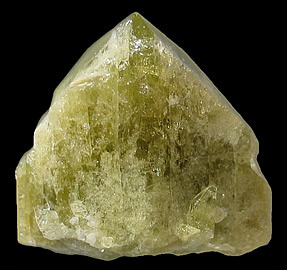
click on image
for larger view
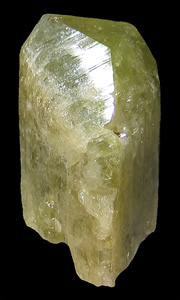
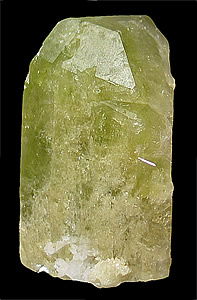
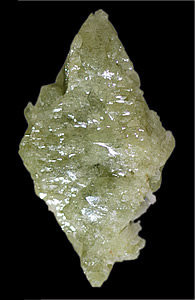
click on image
for larger view
BRAZ8-1
Brazilianite (DT) $650 SOLD
Telírio claim, Linópolis, Divino das Laranjeiras
Doce valley, Minas Gerais, Brazil
6.6 cm x 6.2 cm x 3.7 cm
One huge crystal of Brazilianite (NaAl3[(OH)2|PO4]2) with sharply defined, glossy faces. The bottom portion of the crystal is actually terminated, as seen in the lower right photo, making this a doubly-terminated floater crystal. Portions of the crystal fluoresce yellow under SWUV.
![]()
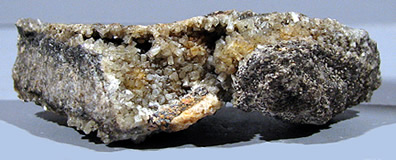
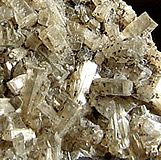
click on images
for larger view
image on right is 11 x 11 mm
BREW9-1 Brewsterite $22 SOLD
Whitesmith Mine, Strontian, North West Highlands, Scotland, UK (TL)
6.6 cm x 2 cm x 3.7 cm; largest crystal ~ 3 mm
Brewsterite-Sr, (Sr,Ba,Ca)[Al2Si6O16] · 5H2O, is an uncommon zeolite. This specimen has seams running throughout it with crystals tucked into the spaces. The Whitesmith Mine is an open cut barite-lead-zinc-silver mine, and the Scottish village of Strontian is the type locality for the species. Strontian is an old mining district which gave its name to the chemical element Strontium - not the other way around, as I had always assumed! And yes, it is also the type locality for Strontianite.
![]()
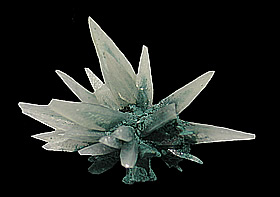

ordinary light
click
on image for larger view SWUV
CAL5-20 Calcite $28 SOLD
Iraí, Alto Uruguai region, Rio Grande do Sul, Brazil
4 x 3.5 x 3 cm
A couple of cleaved tips on the edge crystals, but really great red fluorescence in SWUV, as only a good Calcite (CaCO3) can do.
![]()

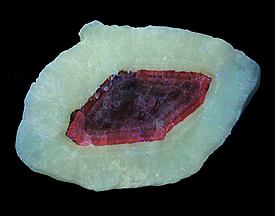
ordinary light
click
on image for larger view SWUV
CAL8-9 Calcite $35 SOLD
Baltimore Tunnel, Lion Hill, Ophir, Tooele Co., Utah
5.6 x 3.6 x 3.7 cm
This is actually the tip of a large Calcite (CaCO3) crystal and the photos show the bottom, a cross-section through the crystal that reveals many stages of growth. Each growth stage has a different color under SW ultraviolet light (the photo on the right) - the outer layer fluoresces pale yellow while the inner layers are various shades of red.
![]()
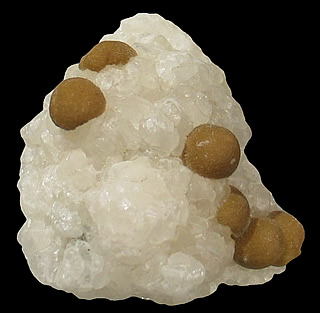
click on image
for larger view
CAL5-89
Calcite on Calcite $155 SOLD
Cavnic Mine, Cavnic, Maramures Co., Romania
6.5 cm x 7 cm x 3.7 cm
Cavnic must surely rank high in a list of mines that produce the most varied Calcite habits in the world, and Calcite does have the most variety of forms of all minerals. There were 450 photos of Calcite from Cavnic on mindat.org as of 9/15/08. Yet I only found one photo resembling this one, and the green balls were on Rhodochrosite, not Calcite. So this does appear to be a rather rare find. In addition, it attracts a lot of attention on display, unlike most rarities. The balls resemble round rosettes and the matrix looks like a mass of coalesced crystals.
![]()

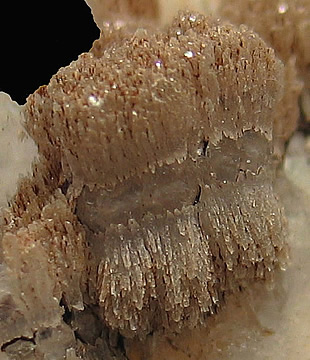
click on image
for larger view
CWS9-1 Calcite "Wheat Sheaves" on Calcite $65 SOLD
Dal'negorsk, Primorskiy Kray, Far-Eastern Region, Russia
8.3 cm x 4.1 cm x 3 cm
This strange Calcite (CaCO3) specimen is extremely interesting and different. The matrix is a stack of white scalenohedra, possibly covering a center Calcite crystal, because it has a triangular cross-section. Then topping some of the stacks are the "Wheat Sheaves" shown in detail in the photo on the right, complete with center bands. The white Calcites and the center band on the wheat sheaves go red under SWUV.
![]()
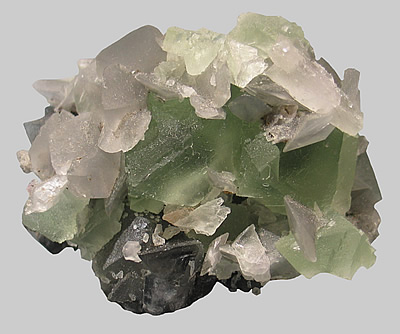
click on image
for larger view
CONF6-1
Calcite on 3 Generations of Fluorite $225
SOLD
Xianghualing Mine, Linwu Co., Hunan, China
8 cm x 5.2 cm x 5.5 cm
The first generation of Fluorite (CaF2) is the layer of gray octahedra on the bottom. The second layer consists of bright green octahedra, and the third generation is a very light green (almost colorless) layer of highly modified cubes visible at top center of the photo. Finally, a handful of colorless, lens-shaped (poker-chip) Calcites (CaCO3) are sprinkled over the top. A lot of mineralogy is captured in this specimen, which is sort of a 3-D, time-lapse photograph of geologic processes, from a one-time find 6 to 7 years back. Most of the specimens from that find had two generations of Fluorite, only occasionally with the Calcites; extremely few had three generations plus Calcite. The Calcites fluoresce red under SWUV and the Fluorite fluoresces purple under LWUV.
![]()
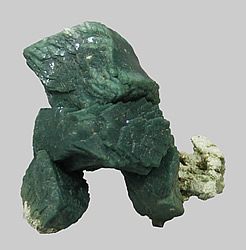
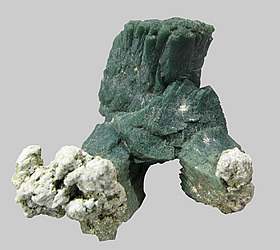
click on image
for larger view
HEU5-13
Celadonite in Heulandite $40 SOLD
Jalgaon, Maharashtra, India
5.5 cm x 5.4 cm x 3.4 cm
Heulandite ((Ca,Na)2-3Al3(Al,Si)2Si13O36•12H2O) gives the form and Celadonite (K(Mg,Fe2+)(Fe3+,Al)[(OH)2|Si4O10]) inclusions give the color to this mineral specimen. Celadonite is quite a rare mineral on its own (I have one specimen from Egypt), so it was surprising to find that it was the source of the color in the green Heulandites, which are fast disappearing from the market. This one still has a bit of matrix stuck to it in an artsy sort of way, the color is rich and dark, and the luster is good.
![]()
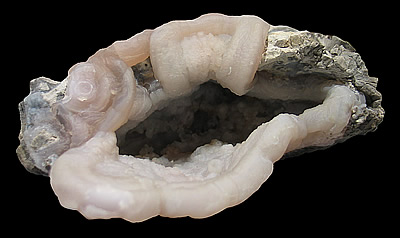
ordinary light
click
on image for larger view

SWUV click
on image for larger view
CHCD7-06 Quartz variety Chalcedony $28 SOLD
Yankee Dog Claim, Hidalgo Co., New Mexico
10 x 4.5 x 6 cm
These Chalcedony nodules from the Yankee Dog Claim have to be some of the most oddly-shaped mineral specimens ever, and this particular one looks like a mouth with a tongue! Under SWUV it is brilliant green. It responds a little under LWUV, but not as brightly.
![]()
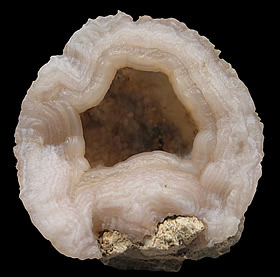
ordinary light
click on image for larger view
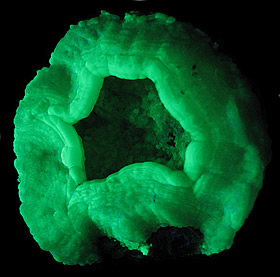
SWUV click
on image for larger view
CHCD7-09 Quartz variety Chalcedony $25 SOLD
Yankee Dog Claim, Hidalgo Co., New Mexico
6 x 6.2 x 4 cm
Here's another geode-like Chalcedony specimen from the Yankee Dog Claim with a nice wide rim that fluoresces brilliant green under SWUV. It responds a little under LWUV, but not as brightly.
![]()

click on image
for larger view
CCC6-2
Chalcocite, Bornite & unknown $95 SOLD
Dzhezkazgan Mine, Dzhezkazgan, Zhezqazghan Oblysy, Kazakhstan
8 cm x 7.9 cm x 3.2 cm
Chunky rounded Bornite (Cu5FeS4) crystals to 1 cm and angular Chalcocite (Cu2S) crystals to 0.8 cm are strewn over a matrix of Calcite, accompanied by some spindly crystals that were identified as a Chalcocite pseudomorph of Stromeyerite (AgCuS) by the person who sold me this piece. Silver is indeed found at Dzhezkazgan and the shape of the crystals seems consistent with the shape of Stromeyerite, so that claim is plausible. But Chalcocite can also occur in acicular habits, so another possibility is that there are two contrasting habits of Chalcocite present on this specimen. Either way, an extremely interesting assemblage of copper sulfides.
![]()
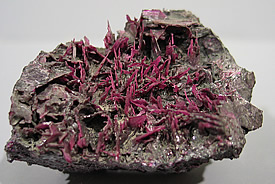

top view - click
on image for larger view - side
view
CrS8-1
Chrome Slag $35 SOLD
Smelter at Vargön Alloys AB, Vargön, Västra Götaland,
Sweden
6.3 cm x 4.5 cm x 3.5 cm; crystal size = 0.7 cm
This is one for the person who is interested in industrial uses of minerals. There is an abundance of delicate sail-shaped crystals of a smelter product that is undoubtedly high in chrome content, since the crystals are about the same color as Chromian Clinochlore or Chromian Amesite. The matrix also has flecks of purple and a metallic scent. Vargön Alloys is one of Europe’s largest producers of ferro chrome and has an interesting website to peruse:
Click here to visit Vargön Alloy's Website
![]()

click on image
for larger view
CoD8-1
Cobaltoan Dolomite $150 SOLD
Tsumeb Mine, Tsumeb, Otjikoto Region, Namibia
1.7 cm x 4.2 cm x 1.2 cm
This bright pink Dolomite ((Ca,Mg,Co)CO3) toenail from a classic locality fluoresces pink-red under SWUV. While looking at this piece, I saw a picture in its shape – a student at a desk, raising his hand. Click here to see what I saw: KID
![]()

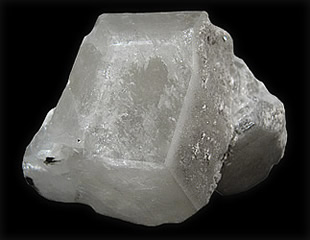
click on image
for larger view
COLE5-3
Colemanite (TL) $45 SOLD
Boraxo Pit, Furnace Creek District, Death Valley, Inyo Co., California
6.5 cm x 6 cm x 5.5 cm
A chunky Colemanite (Ca[B3O4(OH)3] • H2O) specimen from the type locality. Most Colemanites are of the bladed habit, but Furnace Creek Colemanites are blocky, with silky surfaces. Under SWUV it fluoresces cream white and phosphoresces for a few seconds after the lamp is turned off. Under LWUV, the fluorescence is slightly yellow-orange. The main crystal is 4 cm wide with at least a dozen smaller crystals attached. It was collected by James and Dawn Minette in the 1970’s.
![]()

click on image
for larger view
CORN8-1
Cornetite (TL) $38 SOLD
L'Etoile du Congo Mine, Katanga, Katanga Copper Crescent
Democratic Republic of Congo
6.1 cm x 6.1 cm x 1.3 cm
From the type locality, an older style of Cornetite (Cu3[(OH)3|PO4]) in which the crystals are flat-lying and separated. There are crystals on five sides, with the highest crystal density on the front. Very interesting with a loupe or microscope, yet pretty enough for display.
![]()
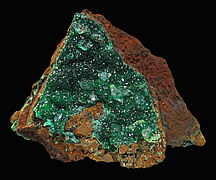
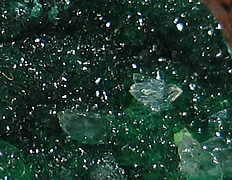
click on image
for larger view
CuADM6-3
Cuprian Adamite $26
SOLD
Ojuela Mine, Mapimí, Mun. de Mapimí, Durango, Mexico
4.1 cm x 3.2
cm x 1.1 cm
Intense, deep green, botryoidal Cuprian Adamite ((Zn,Cu)2AsO4OH) forms a crust on the gossan matrix of this specimen. I read that the deep green was a small, one-time find. There are a few colorless Calcites associated with the Cuprian Adamite, as can be seen in the detail photograph on the right.
![]()
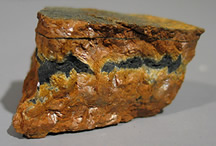
click on image
for larger view
DAD9-1 Dadsonite in Siderite $35 SOLD
Saint-Pons,
Ubaye valley, Alpes-de-Haute-Provence,
Provence-Alpes-Côte d'Azur, France
3.7 cm x 2 cm x 2.3 cm
A seam of black Dadsonite (Pb23Sb25S60Cl) sandwiched between layers of tan Siderite (FeCO3) from a classic locality in France. Dadsonite was named after Canadian mineralogist Alexander S. Dadson.
![]()
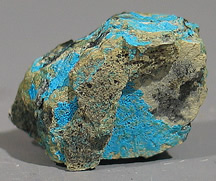
click on image
for larger view
DECR9-2 Decrespignyite-Y $28 SOLD
Paratoo
copper mine, Yunta, North Mt Lofty Ranges
South
Australia, Australia (TL)
2.5 cm x
1.8 cm x 1.2 cm
This specimen is richly covered with blue spheres of Decrespignyite (Cu(Y,REE)4(CO3)4Cl(OH)5·2H2O). Most of the spheres are so densely packed that they have coalesced, but in some places the individual balls are naked-eye visible. This specimen is from the type locality, a small copper mine that is known for an unusual collection of REE carbonates. REE means Rare Earth Elements which is a designation for the following group of 17 elements: scandium, yttrium, lanthanum, cerium, praseodymium, neodymium, promethium, samarium, europium, gadolinium, terbium, dysprosium, holmium, erbium, thulium, ytterbium and lutetium. By using REE, the chemical formula indicates that any of these elements are acceptable constituents.
![]()
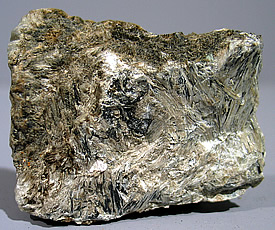
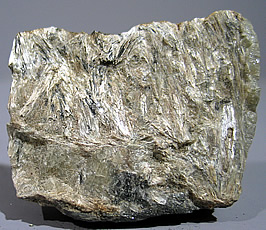
click on image
for larger view
DENIS9-1 Denisovite $40 SOLD
Yukspor
Mt, Khibiny Massif, Kola Peninsula
Murmanskaja Oblast', Northern Region, Russia (TL)
5 cm x 4 cm x 2.7 cm
White fibrous Denisovite (Ca2(K,Na)Si3O8(F,OH)2) on a matrix of Aegirine (NaFe3+[Si2O6]) from the type locality. Denisovite is only known from one other locality outside the Khibiny Massif. Denisovite is an asbestiform mineral, meaning that it resembles the six minerals that are legally defined as asbestos, but is not one of them. Asbestiform minerals are perfectly safe in a mineral collection.
![]()
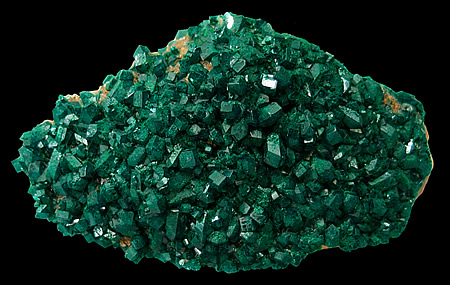
click on image
for larger view
DPT8-2
Dioptase (TL) on Quartz $575 SOLD
Altyn-Tyube deposit, Kirghiz Steppes
Qaraghandy Oblysy, Kazakhstan
11 cm x 6 cm x 2.5 cm
A large, showy Dioptase (Cu6(Si6O18)·6H2O) from the type locality, nearly pristine, and with crystals to 0.9 cm. Nothing can top the color of Dioptase, and this is a large piece that definitely deserves to be on display. Curiously, if it were from Tsumeb, the price would need to have another zero; but the type locality does not command the same prices, so this is a way for most collectors to be able to put a display-size Dioptase on their shelves.
![]()
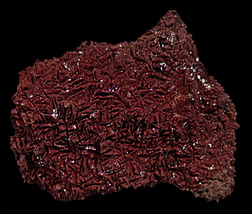
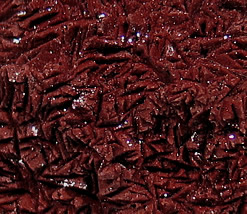
click on image
for larger view
DOL9-1 Dolomite $28 SOLD
Tsumeb Mine, Tsumeb, Otjikoto Region, Namibia
5 cm x 4.3 cm x 1 cm
This crust of sparkling, red-brown Dolomite (CaMg(CO3)2) forms a distorted map of Australia that is only a couple of millimeters thick. There's a small, clear Calcite or two on top of the Dolomite, and several more on the backside, so whatever produced the crust must have dissolved away before the Calcites formed.
![]()
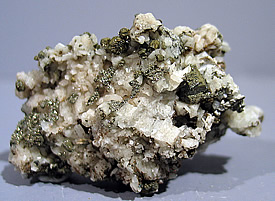
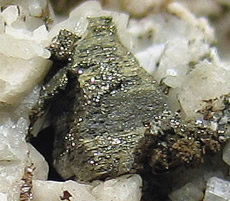
click on left
image for larger view
image on right is 10 x 10 mm
DONN9-1 Donnayite-(Y) on Albite with Pyrite $55 SOLD
Poudrette
Quarry, Mont Saint-Hilaire
Rouville County, Québec, Canada (TL)
6.3 cm x 4 cm x 4 cm; largest crystal = 8 mm
Donnayite-(Y) (Sr3NaCaY(CO3)6·3H2O) is an extremely rare mineral found in only half a dozen localities worldwide, the most well-known of which is the Poudrette Quarry at Mont Saint-Hilaire, also the type locality. Mont Saint-Hilaire produces the largest and best crystals, although it is still rare to get crystals more than a few millimeters in size. The largest Donnayite on this specimen is 8 mm, with at least 2 dozen other smaller ones. Donnayite forms pseudohexagonal crystals of varying cross-section, reminiscent of its chemical relative, Weloganite. The well-formed while Albites and the sprinkling of bright Pyrite give this rare specimen an unusual beauty.
![]()

click on image
for larger view
DRES8-1
Dresserite (TL) $45 SOLD
Francon quarry, St. Michel district, Montréal, Québec,
Canada
2.5 cm x 1.5 cm x 1.3 cm
More than a dozen balls of white Dresserite (BaAl2[(OH)2|CO3]2• H2O) from the type and apparently only locality. The Dresserite fluoresces white in both SWUV and LWUV, and the matrix hosts some other microminerals that fluoresce yellow and red. This quarry was closed in 1981, and according to www.mindat.org, will never be active again. So these older specimens are currently the only source of this mineral.
![]()
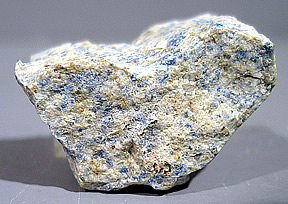
click on image
for larger view
DUMOR9-1 Dumortierite $25 SOLD
Gora Aktash, Tashkent Viloyati, Uzbekistan
3.7 cm x 2.5 cm x 2 cm
The Dumortierite (Al,Fe3+)7[O3|BO3|(SiO4)3] is the blue portion of this specimen. Interestingly, Uzbekistan is not even mentioned by mindat.org as a locality for Dumortierite, but the specimen was obtained from Dmitriy Belakovskiy, a curator of the Fersman Mineralogical Museum, so I trust the identification and locality information. It comes with his style of label (it doesn't mention his name, but anyone who has purchased rocks from him at mineral shows will recognize it), glued to the box, with the mineral name written in Russian and the chemical formula supplied.
![]()
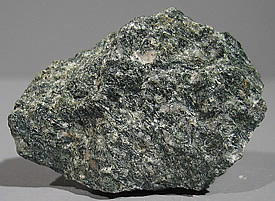
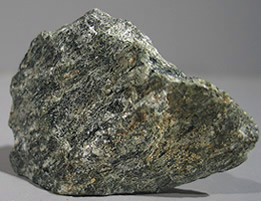
click on image
for larger view
ECKER9-1 Eckermannite $18 SOLD
Norra Kärr, Gränna, Jönköping, Småland, Sweden (TL)
6.2 cm x 4.4 cm x 2.3 cm
This specimen consists of green-gray fibers of Eckermannite ([Na][Na2][(Mg,Fe2+)4Al][(OH)2|Si8O22]) mined at the type locality. Eckermannite is a clinoamphibole and an inosilicate. Like the Denisovite above, it probably qualifies as another asbestiform mineral, although the fibers in this specimen are tightly compacted.
![]()
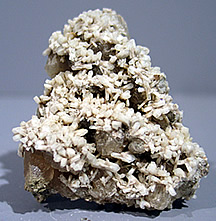
click on image
for larger view
EDI9-1 Edingtonite $45 SOLD
Ice
River Alkaline Complex, Golden Mining Division
British Columbia, Canada
4.1 cm x 5.5 cm x 2 cm; largest crystal = 7 mm
Edingtonite
(Ba[Al2Si3O10]
· 4H2O)
is one of the rarer zeolites, and the Ice River locality is a standard
for the species. The Edingtonites are richly sprinkled on colorless
calcites.
![]()
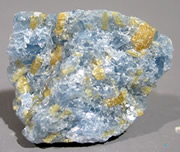
click on image
for larger view
ELLE9-1 Ellestadite-(Cl) $16 SOLD
Crestmore Quarries, Riverside County, California (TL)
2.6 cm x 2.1 cm x 1.5 cm
Numerous yellow prismatic Ellestadite-(Cl) (Ca10[Cl2|(SO4)3|(SiO4)3]) crystals frozen in blue Calcite (CaCO3) from the type locality.
![]()
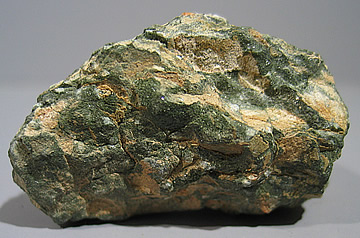
click on image
for larger view
ELP9-1 Elpidite and Arfvedsonite $22 SOLD
Khan Bodgo Massif, Central Gobi Desert, Mongolia
5.9 cm x 3.5 cm x 4 cm
This chunk of Mongolia contains large orange-brown crystal sections of Elpidite (Na2ZrSi6O15·3H2O) with greenish, fibrous Arfvedsonite [Na][Na2][Fe2+4Fe3+][(OH)2|Si8O22]. High-temperature Elpidites like this one are usually enriched with Ca and K, and are formed in superalkaline granitic massifs. The Khan Bodgo Massif is one of only a few such massifs that are known.
![]()
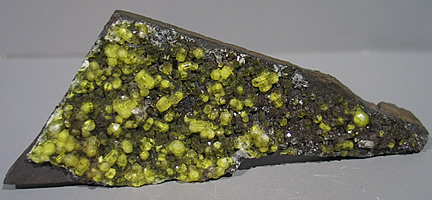
click on image
for larger view
ETT9-1
Ettringite $52 SOLD
N'Chwaning Mines, Kalahari manganese fields, South Africa
12 cm x 4.5 cm x 0.9 cm
Canary-yellow Ettringite Ca6Al2[(OH)4|SO4]3· 26H2O crystals to 6 mm are sprinkled on a thin plate of manganese-rich matrix.
![]()
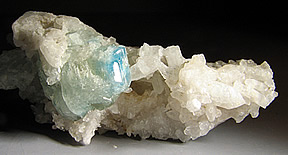
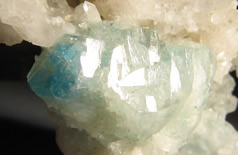
click on image
for larger view
EUC6-1 Euclase on Quartz $75 SOLD
Ouro Preto, Minas Gerais, Southeast Region, Brazil (TL)
4.5 cm x 2 cm x 1.8 cm; Euclase crystal = 1.4 cm x 1 cm
I was very surprised to learn that Ouro Preto is the type locality for Euclase, BeAl[OH|SiO4]. This specimen has a large Euclase crystal embedded in the Quartz matrix. The tip of the crystal is that particular shade of blue that only Euclase seems to acquire, while other portions of the crystal are clear and colorless.
Questions? Please send me an email.
Home | Mineral Galleries | Index of Minerals | Contact | Links | Orders
© 2008 - 2009 Middle Earth Minerals

